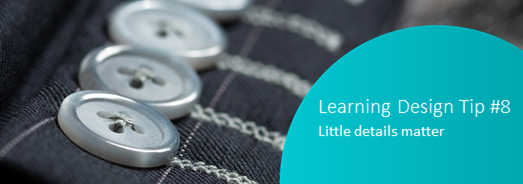You wouldnt think that such small things could have such a big impact Even minor punctuation and speling errors – or those irritating ones wear you used the same sounding word but its a different spelling — inconsistencies in use of symbols – they all add up to you’re learning outcomes crumbling under the weight of all that extra cognitive load, not to mention unhappy clients.
We’ve all read it in a job ad – ‘attention to detail required’. It may not be an exciting thing to list on your resume, but it is important.
Attaining attention to detail requires three key elements: the attitude to desire excellence; knowledge about what the details entail; and skills to use processes and tools that can help you attain a high standard of quality.
Attitude
Excellence is an attitude, a mindset. It plays out in the design process in a myriad of ways. It shapes the chosen learning approach, the quality of external content and the exploratory questions that you ask SMEs to gain clarity about content. It drives your continuing professional development to stay at the forefront of your profession and it motivates discretionary effort. It’s not always noticed when it is there, but it’s always noticed when it’s not there.
Achieving excellence is a collaborative endeavour. It involves establishing team processes (for example, shared proof reading, review and feedback stages, co-design sessions) that will not just create an excellent product, but will create a culture where excellent products are inevitable.
Knowledge
Depending on when you went to school, you either learnt grammar, or not. Regardless, you need it now. Fortunately, it’s possible to improve by simply taking the time to pay attention to the various grammar checkers available and the explanations that they give. Not knowing a rule is okay the first time, but repeatedly breaking it is not.
Most industries and/or professions have particular conventions for writing and production (and they’re not all about spelling and grammar). Being familiar with these will give your work internal consistency and also maintain consistency across projects. This applies across all elements of the design process – graphics and visual design, language, tone or ‘voice’, clarity in on-screen directions, referencing and linking protocols.
Skills to use processes and tools
Use a style manual. Are you unsure if your bullet points need capitals? Look it up. It’s that simple. Choose a standard (or use the one relevant to your client) and stick to it. Closely related to a style manual is a brand guide, stipulating logo usage, colour palettes and primary and secondary fonts. Just find the standard and stick to it.
Create a checklist of common errors to bring your design and writing temporarily into the ‘conscious competence’ state. After doing this for a while, those standards will become part of your unconscious competence processes.
Proof read in a brain-saving way. Use the Find/Replace feature of your word-processing software to help spot common style errors. For example, it’s easy to search for quotation marks, double spaces and hyphens in your writing to ensure you’ve used them correctly every single time. This frees up your focus to proof read specifically for the common errors that can’t be easily searched and don’t get picked up in automatic spelling and grammar checkers.
In summary
Attention to detail is a small investment that pays big dividends! Making fewer errors in your design results in time savings in the review and correction process. As you build quality, professional, effective learning experiences, you build a strong reputation and expand your network and client base. That’s something worth paying attention to.
Interested in a deep dive?
- Grammarly provides a free, AI-powered writing assistant.
- The Australian Government Digital Transformation Agency provides a Style Manual.
- Josh Bersin shares the best advice he’s ever received – pay attention to detail.
- Duncan Koerber provides an extensive list of editing and proofreading tips.
- Yael Vevey outlines some underrated skills every designer should cultivate.
What will you do?
Did you pick up all eight errors in the opening paragraph?
Start a checklist of the most common errors that you make.
Get it touch!
Contact us at easyA to explore how our learning solutions design team can work with your organisation: www.easyauthoring.com

